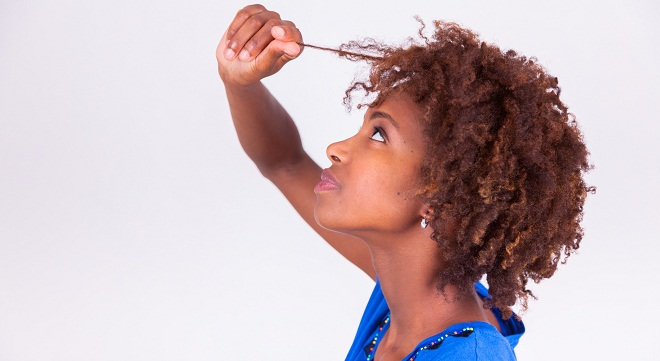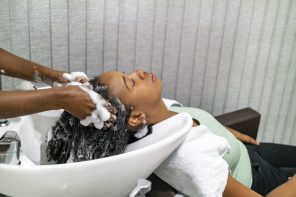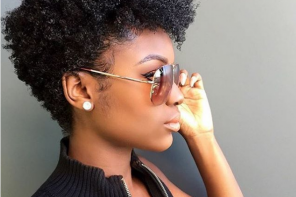This article was first posted on July 27, 2018 and updated on August 9, 2021.
To make the best choice in deciding which products you should include in your hair regimen, it is vital for you to learn about hair porosity. In this article, I am going share with you how and why you need to understand your hair porosity, what it is, and what you can do about it.

WHAT IS HAIR POROSITY AND IT’S LEVELS
Before we get to far, it is important to establish a shared understanding of what hair porosity is. Put simply, hair porosity is your hair’s ability to maintain moisture. However, we all have a unique porosity that commonly falls within one of three levels.
Low Porosity Hair
If you find that the products you apply on your hair aren’t easily absorbed and usually just sit on your hair, you may have low porosity hair. If you hair appears to be moisturized but feels dry, that’s an indication that your hair may have a low porosity level and that your hair’s cuticles are tightly shut which makes it difficult for moisture to be easily absorbed. Low porosity hair is harder to process because it repels water and resists the penetration of chemicals.
Medium Porosity Hair
If your hair holds moisture and absorbs chemicals and hair color better, then you probably have medium porosity hair. This means that your cuticles are raise just enough to absorb an adequate amount of moisture, oils and any other chemicals. Medium porosity hair usually requires the least bit of maintenance. Occasional protein treatments and deep conditioning is helpful but you don’t need to use protein in your daily hair regimen.
High Porosity Hair
High porosity hair can be caused by chemical processing, rough treatment or environmental damage. In addition, high porosity hair has gaps in the cuticle, which allow too much moisture into your hair and make it more likely to become frizzy and tangled in warm climates. Even simple acts such as bathing, swimming and shampooing can create more damage and breakage due to the sheer amount of moisture highly porous hair can absorb.
HOW TO FIND OUT YOUR LEVEL
The questions above will give you a good preliminary place to start to figure our your hair’s porosity. However, to more specifically figure it out, I suggest two tests. There are two simple ways to help you figure out your hair’s porosity level. It is important to note that these tests are not 100% accurate but are a good way to start:
- The Strand Test: To do this, run your thumb and index finger along a strand of hair. If it feels smooth against your fingers, your hair may likely have a low porosity level. Also, if it feels rough and bumpy, then your hair may be highly porous.
- The Cup Test: To do this, fill up a cup of room temperature water. Preferably have a glass cup where you can see through the cup. Take a few shed hair strands that are already on your brush or comb. Drop a few hair strands into the cup and wait for about 2-4 minutes. If your hair sinks immediately you have high porosity hair. If your hair doesn’t sink at all you have low porosity hair.

HERE’S WHAT YOU CAN DO
Low Porosity Hair Tips:
If you have low porosity, there are a few things you can do about it. Use a steamer or your own body heat by using a plastic cap when you’re conditioning or using moisturizers will help open up the closed cuticle layer. This will allow moisture to seep into the strand.
Medium Porosity Hair Tips:
If your hair falls into this category, then there’s something you can do about it. Occasional deep conditioning treatments with protein conditioners can benefit medium porosity hair, but proteins should not be included in your daily regimen.
High Porosity Hair Tips:
For this category of hair, using leave-in conditioners are going be helpful since they tend to lose moisture. Layering your hair with moisturizers (butters, lotions, etc.) and sealers (oils) can help lock in the moisture that you add in.
Try using the Quench Collection for an entire hair care system to support healthy porosity to moisturizes and nourishes hair to support healthier hair growth.
You will also want to use anti-humectants if you live in a climate with high heat and humidity levels. This will help seal your damaged cuticles and prevent them from absorbing excess moisture in the air.
For a more up-to-date version of this article, please go HERE.Latest posts by Brandelyn Green (see all)
- Everything You Need to Know About Moisturizing Oils Vs. Sealing Oils - February 15, 2024
- 4 Simple Tips To Slay Your Edges that You’ll Love - February 15, 2024
- 5 Benefits of Peppermint Oil That Will Make Your Hair Feel Like New - February 12, 2024










Thank you for the info. I shampooed my hair 8/9/21 condition and leave in conditioner and use exlier. I did use plastic cap during conditioning. My hair feels awesome. When I combed hair out on the 10th no breakage and still moist. My hair broke off to less than 1 inch from chemo and dying hair I started with the exlier first before ordering the other products within 2 weeks just with the oil I saw growth and a difference in breakage now I’m looking for even better. Thank you so much.
Wow Margaret!
That is so awesome to hear! We are so happy to hear that you are seeing such beautiful results.
Please keep up the great work and keep us updated on your journey!
WE LOVE TO HEAR IT <3
I currently use Aveda Cherry Almond Softening Shampoo and Conditioner I love the way it detangles and soften my hair. Would like to go natural fir a while any suggestions
Hi Connie!
Going natural can be overwhelming for some but the advice we’d give is to make sure to keep your hair moisturized! Moisture and protective styles will be your best friend.
I want my natural hair back I want length my curls and ever edges back years I struggle buying products that are expensive I found one buy cannot remember but I just want my hair back
Hello there,
We completely understand and are more than happy to help you achieve your desired hair goals!
With our products, correct use and consistency before you know it your hair with thank you.
If you have any questions, please feel free to contact us at [email protected]
Warmly,
I have trouble keeping my hair moisturize my hair is so thick it’s a moisturizer and to keep my hair growing
Hi Larissa,
It sounds like a good steam treatment could do your hair some good to help lock in some moisture!
Also, you can try the LCO method. L-liquid or leave-in-conditioner , C – Cream or Moisturizer, O- Oil to seal in the moisture.
If you have any additional questions, please feel free to contact us at [email protected].
my baby has natural curl hair easy to get tangle holds water when it drys it looks frizzle what product is good for her hair
Hi Marcia!
Maybe you can try our 3-in-1 Leave In Conditioner! It will help to tame your daughters hair and leave it moisturized!
https://voiceofhaircare.com/products/3-in-1-leave-in-step-3
If you have any questions, please feel free to contact us at [email protected]
Hi I really loved my tight curls now I hardly have a curl I put bleach on my hair in 2019 an left it on to long I wasn’t put enough oil on my my hair either I didn’t know I’m how to maintain color hair I need help it be oily quick it gets brittle it she’d a lot
Hi Miracle, so sorry to hear your hair is shedding. Our Nourish & Grow bundle is great for dry and damaged hair.
Also, you may want to visit a licensed professional to see if you need a protein treatment to help strengthen and repair your hair. Hope this helps! Let us know if you have other questions.